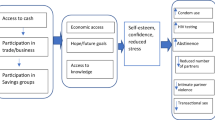Abstract
This study tests whether women’s relationship power modifies the effect of a conditional cash transfer (CCT) on STI risk. We analyzed 988 women enrolled in the RESPECT study in Tanzania, a yearlong, randomized-controlled trial testing the effectiveness of a CCT to reduce STI incidence. Women were randomized at the individual level to a no-cash control group, a low-cash, or a high-cash study arm. After one year, there was no main effect of study arm on risk of having an STI among women. However, in tests of heterogeneity, the effect of the CCT varied by a woman’s relationship power (adjusted RRs of the interaction term for women with higher relationship power: RR 0.567 (95% CI 0.240–0.895) for high cash and RR 1.217 (95% CI 0.794–1.641) for low cash). Specifically, women with higher relationship power in the low cash transfer arm had an elevated risk of testing positive for an STI, whereas women with high relationship power in the high cash transfer arm had a decreased risk of testing positive for an STI.

Similar content being viewed by others
References
MacPhail C, Adato M, Kahn K, et al. Acceptability and feasibility of cash transfers for HIV prevention among adolescent South African women. AIDS Behav. 2013;17(7):2301–12.
Medlin C, De Walque D. Potential applications of conditional cash transfers for prevention of sexually transmitted infections and HIV in Sub-Saharan Africa. World Bank Policy Research Working Paper Series; 2008.
Pettifor A, McCoy SI, Padian N. Paying to prevent HIV infection in young women? Lancet. 2012;379(9823):1280–2.
Baird SJ, Garfein RS, McIntosh CT, Özler B. Effect of a cash transfer programme for schooling on prevalence of HIV and herpes simplex type 2 in Malawi: a cluster randomised trial. Lancet. 2012;379(9823):1320–9.
Baird S, Chirwa E, McIntosh C, Özler B. What happens once the intervention ends? The medium-term impacts of a cash transfer programme in Malawi. 3ie Impact Evaluation Report. 2015;27.
Karim QA. Impact of conditional cash incentives on HSV-2 and HIV in rural high school students in South Africa. In: 8th IAS Conference on HIV Pathogenesis, Treatment & Prevention. Vancouver, Canada; 2015.
Kohler HP, Thornton RL. Conditional cash transfers and HIV/AIDS prevention: unconditionally promising? World Bank Econ Rev. 2011;26(2):165–90.
Björkman Nyqvist M, Corno L, de Walque D, Svensson J. Using lotteries to incentivize safer sexual behavior: evidence from a randomized controlled trial on HIV prevention. World Bank Policy Research Working Paper No. 7215. 2015.
de Walque D, Dow WH, Nathan R, et al. Incentivising safe sex: a randomised trial of conditional cash transfers for HIV and sexually transmitted infection prevention in rural Tanzania. BMJ Open. 2012;2:e000747.
Boerma JT, Weir SS. Integrating demographic and epidemiological approaches to research on HIV/AIDS: the proximate-determinants framework. J Infect Dis. 2005;191(Suppl 1):S61–7.
Pettifor A, MacPhail C, Nguyen N, Rosenberg M. Can money prevent the spread of HIV? A review of cash payments for HIV prevention. AIDS Behav. 2012;16(7):1729–38.
Wingood G. Application of the theory of gender and power to examine HIV-related exposures, risk factors, and effective interventions for women. Health Edu Behav. 2000;27(5):539–65.
Crissman H. Women’s sexual empowerment and contraceptive use in Ghana. Stud Fam Plan. 2012;43(3):201–12.
Corroon M, Speizer IS, Fotso JC, et al. The role of gender empowerment on reproductive health outcomes in urban Nigeria. Matern Child Health J. 2014;18(1):307–15.
Maman S. HIV-positive women report more lifetime partner violence: findings from a voluntary counseling and testing clinic in Dar es Salaam, Tanzania. Am J Public Health. 2002;92(8):1331–7.
Jewkes R, Nduna M, Levin J, et al. Impact of stepping stones on incidence of HIV and HSV-2 and sexual behaviour in rural South Africa: cluster randomised controlled trial. BMJ. 2008;337:a506.
Pulerwitz J. Measuring sexual relationship power in HIV/STD research. Sex Roles. 2000;42(7):637–60.
Aiken LS, West SG, Reno RR. Multiple regression: testing and interpreting interactions. Newbury Park: Sage; 1991.
Ai C, Norton EC. Interaction terms in logit and probit models. Econ Lett. 2003;80(1):123–9.
Jewkes R. Intimate partner violence, relationship power inequity, and incidence of HIV infection in young women in South Africa: a cohort study. Lancet. 2012;376:42–8.
Personal Correspondence with Julie Pulerwiz, July 2014.
Krishnan S, Vohra D, De Walque D, Medlin C, Nathan R, Dow WH. Tanzanian couples’ perspectives on gender equity, relationship power, and intimate partner violence: findings from the RESPECT study. AIDS Res Treat. 2012.
Acknowledgements
We gratefully acknowledge funding support for the overall RESPECT project from the William and Flora Hewlett Foundation (through the Population Reference Bureau), the World Bank Research Committee, the Strategic Impact Evaluation Fund (SIEF), the Bank- Netherlands Partnership Program (BNPP), Trust Fund for Environmentally & Socially Sustainable Development (TFESSD) and Knowledge for Change Program (KCP), managed by the World Bank. The findings, interpretations, and conclusions expressed in this paper are entirely those of the authors. They do not necessarily represent the views of the authors’ institutions or funders or of the International Bank for Reconstruction and Development/World Bank and its affiliated organizations, or those of the Executive Directors of the World Bank or the governments they represent.
Author information
Authors and Affiliations
Corresponding author
Ethics declarations
Conflicts of interest
All authors declare that they have no conflict of interest.
Ethical Approval
All procedures performed in studies involving human participants were in accordance with the ethical standards of the institutional and/or national research committee and with the 1964 Helsinki declaration and its later amendments or comparable ethical standards.
Informed Consent
Informed consent was obtained from all individual participants included in the study.
Rights and permissions
About this article
Cite this article
Cooper, J.E., McCoy, S.I., Fernald, L.C.H. et al. Women’s Relationship Power Modifies the Effect of a Randomized Conditional Cash Transfer Intervention for Safer Sex in Tanzania. AIDS Behav 22, 202–211 (2018). https://doi.org/10.1007/s10461-017-1875-6
Published:
Issue Date:
DOI: https://doi.org/10.1007/s10461-017-1875-6





